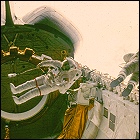 Space Shuttle Challenger lifts off into orbit for the first time, after extensive technical and mechanical issues keep the shuttle on the pad well past its original January launch date. The payload for this flight is NASA’s own TDRS (Tracking & Data Relay Satellite), designed to keep the shuttle in constant contact with ground controllers even if its orbit takes it out of direct communications. The five-day flight also sees the first spacewalk of the shuttle program. Challenger’s crew consists of Commander Paul Weitz, Pilot Karol Bobko, and mission specialists Donald Peterson and Story Musgrave.
Space Shuttle Challenger lifts off into orbit for the first time, after extensive technical and mechanical issues keep the shuttle on the pad well past its original January launch date. The payload for this flight is NASA’s own TDRS (Tracking & Data Relay Satellite), designed to keep the shuttle in constant contact with ground controllers even if its orbit takes it out of direct communications. The five-day flight also sees the first spacewalk of the shuttle program. Challenger’s crew consists of Commander Paul Weitz, Pilot Karol Bobko, and mission specialists Donald Peterson and Story Musgrave.

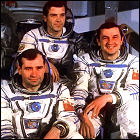 Soyuz T-8 lifts off from the Soviet Union, intended to dock with space station Salyut 7. Cosmonauts Vladimir Titov, Gennady Strekalov and Aleksandr Serebrov are due to take up residence on the station, but discover that the ejection of the nose cone of the Soyuz rocket – which protects the non-aerodynamic Soyuz vehicle during launch – has caused critical damage to the vehicle’s communication equipment. The mission is called off for safety reasons, and the crew returns to Earth after only two days.
Soyuz T-8 lifts off from the Soviet Union, intended to dock with space station Salyut 7. Cosmonauts Vladimir Titov, Gennady Strekalov and Aleksandr Serebrov are due to take up residence on the station, but discover that the ejection of the nose cone of the Soyuz rocket – which protects the non-aerodynamic Soyuz vehicle during launch – has caused critical damage to the vehicle’s communication equipment. The mission is called off for safety reasons, and the crew returns to Earth after only two days.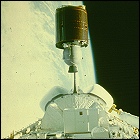 The second flight of Space Shuttle Challenger is a six-day mission to launch two more communications satellites (one for Canada and one for Indonesia), as well as featuring the first American woman in space (20 years behind the Soviet Union’s launch of Valentina Tereshkova). Challenger’s crew for this flight consists of Commander Robert Crippen, Pilot Frederick Hauck, and mission specialists John Fabian, Sally Ride and Norm Thagard.
The second flight of Space Shuttle Challenger is a six-day mission to launch two more communications satellites (one for Canada and one for Indonesia), as well as featuring the first American woman in space (20 years behind the Soviet Union’s launch of Valentina Tereshkova). Challenger’s crew for this flight consists of Commander Robert Crippen, Pilot Frederick Hauck, and mission specialists John Fabian, Sally Ride and Norm Thagard.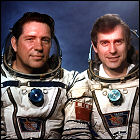 Soyuz T-9 lifts off from the Soviet Union, bringing a new long-term crew to space station Salyut 7. Cosmonauts Vladimir Lyakhov and Aleksandr Aleksandrov take up residence on Salyut 7 for a 150-day stay, including work aboard the recently-docked Kosmos 1443 temporary space station module. The disastrous failure of the next Soyuz mission to reach orbit means that Lyakhov and Aleksandrov spend their entire stay in orbit with no visits from other crews. They return to Earth on November 23rd.
Soyuz T-9 lifts off from the Soviet Union, bringing a new long-term crew to space station Salyut 7. Cosmonauts Vladimir Lyakhov and Aleksandr Aleksandrov take up residence on Salyut 7 for a 150-day stay, including work aboard the recently-docked Kosmos 1443 temporary space station module. The disastrous failure of the next Soyuz mission to reach orbit means that Lyakhov and Aleksandrov spend their entire stay in orbit with no visits from other crews. They return to Earth on November 23rd.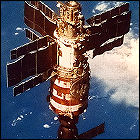 A small object hits one of the windows aboard the Soviet Union’s Salyut 7 space station, leaving a noticeable dent on its exterior layer but not causing enough damage to vent the station’s atmosphere into space (luckily for resident cosmonauts Vladimir Lyakhov and Aleksandr Aleksandrov, who might have to evacuate in their Soyuz T-9 vehicle in such an emergency). Though speculations include a micrometeoroid or wayward debris from a previous space mission, the exact cause of the impact is never confirmed.
A small object hits one of the windows aboard the Soviet Union’s Salyut 7 space station, leaving a noticeable dent on its exterior layer but not causing enough damage to vent the station’s atmosphere into space (luckily for resident cosmonauts Vladimir Lyakhov and Aleksandr Aleksandrov, who might have to evacuate in their Soyuz T-9 vehicle in such an emergency). Though speculations include a micrometeoroid or wayward debris from a previous space mission, the exact cause of the impact is never confirmed.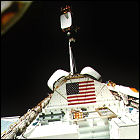 Taking off on a six-day satellite deployment mission, Space Shuttle Challenger also lifts the first African-American astronaut into orbit. A satellite deployment is carried out for India, along with continuing experiments to observe the performance of the shuttle in conditions of extreme cold with limited exposure to the sun. Aboard Challenger for this flight are Commander Richard Truly, Pilot Daniel Brandenstein, and mission specialists Dale Gardner, Guion Bluford, and William Thornton.
Taking off on a six-day satellite deployment mission, Space Shuttle Challenger also lifts the first African-American astronaut into orbit. A satellite deployment is carried out for India, along with continuing experiments to observe the performance of the shuttle in conditions of extreme cold with limited exposure to the sun. Aboard Challenger for this flight are Commander Richard Truly, Pilot Daniel Brandenstein, and mission specialists Dale Gardner, Guion Bluford, and William Thornton.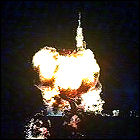 For the first time in history, a launch abort escape system saves its crew from a doomed launch. When a fuel spill is ignited at the base of the launch vehicle for Soyuz T-10-A – an otherwise routine mission to Soviet space station Salyut 7 – the entire rocket catches fire, and ground controllers quickly discover that cables running from their bunker to the vehicle have been severed, preventing them from remotely activating the launch escape tower. A radio frequency backup system finally sends the signal, and the tower blasts the Soyuz capsule free of its doomed rocket just two seconds prior to a massive explosion on the pad. The capsule brings the crew to a safe, but rough, landing a few miles away, while the launch pad fire burns out of control for nearly a day.
For the first time in history, a launch abort escape system saves its crew from a doomed launch. When a fuel spill is ignited at the base of the launch vehicle for Soyuz T-10-A – an otherwise routine mission to Soviet space station Salyut 7 – the entire rocket catches fire, and ground controllers quickly discover that cables running from their bunker to the vehicle have been severed, preventing them from remotely activating the launch escape tower. A radio frequency backup system finally sends the signal, and the tower blasts the Soyuz capsule free of its doomed rocket just two seconds prior to a massive explosion on the pad. The capsule brings the crew to a safe, but rough, landing a few miles away, while the launch pad fire burns out of control for nearly a day.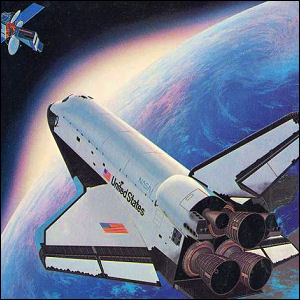 Activision releases
Activision releases 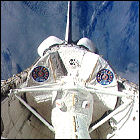 Returning to space after nearly a year of refits, Space Shuttle Columbia lifts off on the long-delayed first manned mission of the Spacelab laboratory module, which is installed in the cargo bay. (The nearly month-long delay was the result of a solid rocket booster issue that led to the first-ever return of the shuttle from the launch pad to the Vehicle Assembly Building.) The ten-day mission also boasts the first six-person shuttle crew, featuring the first Spacelab scientists from the European Space Agency, who have been training for this mission since the 1970s. Columbia’s crew includes Commander John Young, Pilot Brewster Shaw, mission specialists Owen Garriott and Robert Parker, and ESA payload specialists Byron Lichtenberg and Ulf Merbold.
Returning to space after nearly a year of refits, Space Shuttle Columbia lifts off on the long-delayed first manned mission of the Spacelab laboratory module, which is installed in the cargo bay. (The nearly month-long delay was the result of a solid rocket booster issue that led to the first-ever return of the shuttle from the launch pad to the Vehicle Assembly Building.) The ten-day mission also boasts the first six-person shuttle crew, featuring the first Spacelab scientists from the European Space Agency, who have been training for this mission since the 1970s. Columbia’s crew includes Commander John Young, Pilot Brewster Shaw, mission specialists Owen Garriott and Robert Parker, and ESA payload specialists Byron Lichtenberg and Ulf Merbold.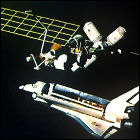 As part of his annual State of the Union address, President Ronald Reagan commits NASA’s resources to building a space station in Earth orbit using the unique space cargo delivery and construction/repair capabilities of NASA’s Space Shuttle fleet. The space agency draws up various plans for stations of varying sizes, ranging from not much bigger than the Apollo/Saturn-derived Skylab of the 1970s to an eventual proposal for a large, “dual keel” design that could become home base for lunar and planetary exploration. All of the proposals, with their multi-billion-dollar cost estimates, instantly find opponents in Congress: the road to a permanently crewed space station will be a long one.
As part of his annual State of the Union address, President Ronald Reagan commits NASA’s resources to building a space station in Earth orbit using the unique space cargo delivery and construction/repair capabilities of NASA’s Space Shuttle fleet. The space agency draws up various plans for stations of varying sizes, ranging from not much bigger than the Apollo/Saturn-derived Skylab of the 1970s to an eventual proposal for a large, “dual keel” design that could become home base for lunar and planetary exploration. All of the proposals, with their multi-billion-dollar cost estimates, instantly find opponents in Congress: the road to a permanently crewed space station will be a long one. Space Shuttle Challenger lifts off on a satellite delivery mission, but the launches of both satellites go awry when their boosters (the Payload Assist Modules designed to launch satellites from the shuttle) put them in the wrong orbits. A German satellite is retrieved, repaired, and placed back into its orbit. A few days after launch, a member of Challenger’s crew will become the first free-floating human satellite. On this flight, Challenger’s crew consists of Commander Vance Brand, Pilot Robert Gibson, mission specialists Bruce McCandless, Ronald McNair and Robert Stewart. This is the first shuttle flight to end on the runway at Kennedy Space Center, eliminating the need for a costly, time-consuming 747 ferry flight to retrieve the shuttle from Edwards Air Force Base.
Space Shuttle Challenger lifts off on a satellite delivery mission, but the launches of both satellites go awry when their boosters (the Payload Assist Modules designed to launch satellites from the shuttle) put them in the wrong orbits. A German satellite is retrieved, repaired, and placed back into its orbit. A few days after launch, a member of Challenger’s crew will become the first free-floating human satellite. On this flight, Challenger’s crew consists of Commander Vance Brand, Pilot Robert Gibson, mission specialists Bruce McCandless, Ronald McNair and Robert Stewart. This is the first shuttle flight to end on the runway at Kennedy Space Center, eliminating the need for a costly, time-consuming 747 ferry flight to retrieve the shuttle from Edwards Air Force Base.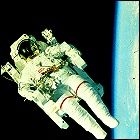 Astronaut Bruce McCandless becomes the first untethered human spacewalker when he leaves the cargo bay of Space Shuttle Challenger aboard a Manned Maneuvering Unit, a jetpack-like device allowing him to maneuver freely with no hoses or cables connecting him to the shuttle. In development since the Gemini era, and tested briefly aboard Skylab in prototype form, the MMU will see use on only three missions before NASA puts it in mothballs.
Astronaut Bruce McCandless becomes the first untethered human spacewalker when he leaves the cargo bay of Space Shuttle Challenger aboard a Manned Maneuvering Unit, a jetpack-like device allowing him to maneuver freely with no hoses or cables connecting him to the shuttle. In development since the Gemini era, and tested briefly aboard Skylab in prototype form, the MMU will see use on only three missions before NASA puts it in mothballs. Delayed many months during the investigation into the causes of the Soyuz T-10a near-disaster in 1983, Soyuz T-10 lifts off from the Soviet Union. Cosmonauts Leonid Kizim, Vladimir Solovyov and Oleg Atkov take up residence on space station Salyut 7 for a 236-day stay – the longest duration crew of the entire Salyut space station program – during which they have to conduct repairs to the station both inside and outside in a series of spacewalks. Left unoccupied months longer than expected, the station has powered down and must be reactivated, a process taking nearly ten days. A fuel line break on the exterior of the station must be repaired as well. The crew remains aboard Salyut 7 through October.
Delayed many months during the investigation into the causes of the Soyuz T-10a near-disaster in 1983, Soyuz T-10 lifts off from the Soviet Union. Cosmonauts Leonid Kizim, Vladimir Solovyov and Oleg Atkov take up residence on space station Salyut 7 for a 236-day stay – the longest duration crew of the entire Salyut space station program – during which they have to conduct repairs to the station both inside and outside in a series of spacewalks. Left unoccupied months longer than expected, the station has powered down and must be reactivated, a process taking nearly ten days. A fuel line break on the exterior of the station must be repaired as well. The crew remains aboard Salyut 7 through October.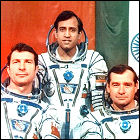 The Soviet Union launches Soyuz T-11 en route to space station Salyut 7. Spending nearly eight days in orbit, cosmonauts Yuri Malyshev, Gennady Strekalov and the first space traveler from India, Rakesh Sharma, perform experiments aboard the station as well as bringing supplies. They return to Earth on April 11th aboard the station crew’s Soyuz T-10 capsule, leaving the newer Soyuz T-11 docked at Salyut 7 for the station crew’s use.
The Soviet Union launches Soyuz T-11 en route to space station Salyut 7. Spending nearly eight days in orbit, cosmonauts Yuri Malyshev, Gennady Strekalov and the first space traveler from India, Rakesh Sharma, perform experiments aboard the station as well as bringing supplies. They return to Earth on April 11th aboard the station crew’s Soyuz T-10 capsule, leaving the newer Soyuz T-11 docked at Salyut 7 for the station crew’s use.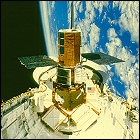 Space Shuttle Challenger lifts off on the first mission to retrieve a satellite in orbit, repair it, and release it back into that orbit. Launched in 1980, prior to the first shuttle mission, the Solar Maximum (Solar Max) Satellite is outfitted with a mechanism to allow the shuttle’s remote manipulator arm to grasp it; however, two astronauts using Manned Maneuvering Units still have to nudge it into Challenger’s cargo bay. With repairs completed, Solar Max is returned to its orbit, where it lasts until 1989. Challenger’s crew on this flight consists of Commander Bob Crippen, Pilot Francis Scobee, and mission specialists Geroge Nelson, James Van Hoften and Terry Hart.
Space Shuttle Challenger lifts off on the first mission to retrieve a satellite in orbit, repair it, and release it back into that orbit. Launched in 1980, prior to the first shuttle mission, the Solar Maximum (Solar Max) Satellite is outfitted with a mechanism to allow the shuttle’s remote manipulator arm to grasp it; however, two astronauts using Manned Maneuvering Units still have to nudge it into Challenger’s cargo bay. With repairs completed, Solar Max is returned to its orbit, where it lasts until 1989. Challenger’s crew on this flight consists of Commander Bob Crippen, Pilot Francis Scobee, and mission specialists Geroge Nelson, James Van Hoften and Terry Hart.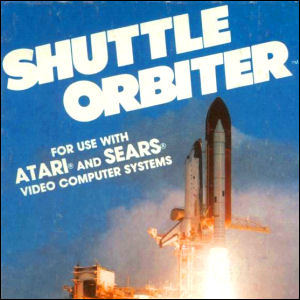 Avalon Hill, a company best known for its boardgame and tabletop wargaming catalog, releases
Avalon Hill, a company best known for its boardgame and tabletop wargaming catalog, releases  The Soviet Union launches Soyuz T-12 on a mission to space station Salyut 7. Cosmonauts Vladimir Dzhanibekov, Svetlana Savitskaya and Igor Volk visit the station crew and test new equipment during a three-hour spacewalk. Savitskaya becomes the first woman to fly in space twice as well as the first female spacewalker, an assignment that seems to have been devised purely for the political purpose of beating NASA to that first (the American space agency having announced in 1983 that an upcoming shuttle mission would feature a female spacewalker). Volk’s presence aboard the mission ensures that he has spaceflight experience ahead of his next mission, believed to be the first manned flight of the Soviet Buran shuttle. The Soyuz T-12 crew is in space for almost 12 days, returning to Earth on July 29th.
The Soviet Union launches Soyuz T-12 on a mission to space station Salyut 7. Cosmonauts Vladimir Dzhanibekov, Svetlana Savitskaya and Igor Volk visit the station crew and test new equipment during a three-hour spacewalk. Savitskaya becomes the first woman to fly in space twice as well as the first female spacewalker, an assignment that seems to have been devised purely for the political purpose of beating NASA to that first (the American space agency having announced in 1983 that an upcoming shuttle mission would feature a female spacewalker). Volk’s presence aboard the mission ensures that he has spaceflight experience ahead of his next mission, believed to be the first manned flight of the Soviet Buran shuttle. The Soyuz T-12 crew is in space for almost 12 days, returning to Earth on July 29th. Space Shuttle Discovery makes its first flight into space on a mission to deploy three commercial communications satellites. Tested on this flight is a huge solar power panel which unfolds vertically from Discovery’s cargo bay, testing technology for space station designs still on the drawing board. Discovery’s crew for this flight consists of Commander Henry Hartsfield, Pilot Michael Coats, mission specialists Judy Resnick, Steven Hawley, Mike Mullane, and payload specialist Charles Walker.
Space Shuttle Discovery makes its first flight into space on a mission to deploy three commercial communications satellites. Tested on this flight is a huge solar power panel which unfolds vertically from Discovery’s cargo bay, testing technology for space station designs still on the drawing board. Discovery’s crew for this flight consists of Commander Henry Hartsfield, Pilot Michael Coats, mission specialists Judy Resnick, Steven Hawley, Mike Mullane, and payload specialist Charles Walker.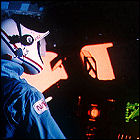 Space Shuttle Challenger lifts off on an eight-day mission, the first shuttle mission with a seven-person crew, which also happens to be the first American shuttle crew with two women on board. A satellite to study radiation around the Earth is deployed, along with an experiment to study the feasibility of refueling empty satellites to extend their service life. Challenger’s crew for this flight consists of Commander Robert Crippen, Pilot Jon McBride, mission specialists Kathryn Sullivan, Sally Ride, David Leestma and payload specialists Marc Garneau and Paul Scully-Power.
Space Shuttle Challenger lifts off on an eight-day mission, the first shuttle mission with a seven-person crew, which also happens to be the first American shuttle crew with two women on board. A satellite to study radiation around the Earth is deployed, along with an experiment to study the feasibility of refueling empty satellites to extend their service life. Challenger’s crew for this flight consists of Commander Robert Crippen, Pilot Jon McBride, mission specialists Kathryn Sullivan, Sally Ride, David Leestma and payload specialists Marc Garneau and Paul Scully-Power.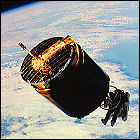 Space Shuttle Discovery takes off on a week-long satellite deployment mission, delivering a Canadian communications satellite and another American SYNCOM defense communications satellite into orbit. Using the MMU jet packs, Discovery’s crew retrieve two satellites placed into the wrong orbits by malfunctioning boosters after a shuttle mission earlier in the year, returning them to the cargo bay for return to Earth. Discovery’s crew consists of Commander Frederick Hauck, Pilot David Walker, and mission specialists Anna Fisher, Dale Gardner, and Joseph Allen.
Space Shuttle Discovery takes off on a week-long satellite deployment mission, delivering a Canadian communications satellite and another American SYNCOM defense communications satellite into orbit. Using the MMU jet packs, Discovery’s crew retrieve two satellites placed into the wrong orbits by malfunctioning boosters after a shuttle mission earlier in the year, returning them to the cargo bay for return to Earth. Discovery’s crew consists of Commander Frederick Hauck, Pilot David Walker, and mission specialists Anna Fisher, Dale Gardner, and Joseph Allen.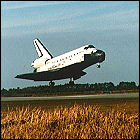 Space Shuttle Discovery lifts off on the shortest shuttle flight since the 1981 test flights, lasting only three days. A classified Defense Department payload is delivered to orbit, with the help of the first Inertial Upper Stage booster developed by the U.S. Air Force. This mission is the first time that shuttles had to be swapped out prior to flight – thermal tile issues on Challenger prevented that shuttle from being used for this mission – as well as the first instance of a shuttle launch scrubbed because of concerns over freezing weather and ice at the launch site. Discovery returns via the Kennedy Space Center runway, with Commander Ken Mattingly, Pilot Loren Shriver, mission specialists Ellison Onizuka and James Buchli, and payload specialist Gary Payton aboard.
Space Shuttle Discovery lifts off on the shortest shuttle flight since the 1981 test flights, lasting only three days. A classified Defense Department payload is delivered to orbit, with the help of the first Inertial Upper Stage booster developed by the U.S. Air Force. This mission is the first time that shuttles had to be swapped out prior to flight – thermal tile issues on Challenger prevented that shuttle from being used for this mission – as well as the first instance of a shuttle launch scrubbed because of concerns over freezing weather and ice at the launch site. Discovery returns via the Kennedy Space Center runway, with Commander Ken Mattingly, Pilot Loren Shriver, mission specialists Ellison Onizuka and James Buchli, and payload specialist Gary Payton aboard. After four years of construction and an additional year of testing and checkout, the
After four years of construction and an additional year of testing and checkout, the 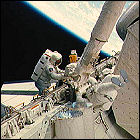 After a month of delays due to damage and a change in the flight schedule, Space Shuttle Discovery returns to orbit for a week-long flight. A Canadian communications satellite and the LEASAT-3 satellite are redeployed, but LEASAT continues to malfunction despite multiple attempts to active and launch it. Discovery’s crew on this flight consists of Commander Karol Bobko, Pilot Donald Williams, mission specialists Rhea Seddon, Jeffrey Hoffman and David Griggs, and payload specialists Charles Walker and Senator Jake Garn, the first member of the U.S. Congress to fly in space while in office. This flight’s return to the runway at Kennedy Space Center marks the first time a shuttle orbiter experiences significant damage upon landing, including a blowout of one of its landing gear wheels.
After a month of delays due to damage and a change in the flight schedule, Space Shuttle Discovery returns to orbit for a week-long flight. A Canadian communications satellite and the LEASAT-3 satellite are redeployed, but LEASAT continues to malfunction despite multiple attempts to active and launch it. Discovery’s crew on this flight consists of Commander Karol Bobko, Pilot Donald Williams, mission specialists Rhea Seddon, Jeffrey Hoffman and David Griggs, and payload specialists Charles Walker and Senator Jake Garn, the first member of the U.S. Congress to fly in space while in office. This flight’s return to the runway at Kennedy Space Center marks the first time a shuttle orbiter experiences significant damage upon landing, including a blowout of one of its landing gear wheels.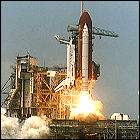 Space Shuttle Challenger lifts off on a week-long mission to perform experiments in the cargo-bay-mounted Spacelab laboratory module. Aboard Challenger for the Spacelab 3 flight are Commander Robert Overmyer, Pilot Frederick Gregory, mission specialists Don Lind, Norm Thagard, and William Thornton, and payload specialists Lodewijk van den Berg and Taylor Wang. Following the landing gear damage experienced by Discovery on its last flight, Challenger makes its landing at Edwards Air Force Base.
Space Shuttle Challenger lifts off on a week-long mission to perform experiments in the cargo-bay-mounted Spacelab laboratory module. Aboard Challenger for the Spacelab 3 flight are Commander Robert Overmyer, Pilot Frederick Gregory, mission specialists Don Lind, Norm Thagard, and William Thornton, and payload specialists Lodewijk van den Berg and Taylor Wang. Following the landing gear damage experienced by Discovery on its last flight, Challenger makes its landing at Edwards Air Force Base. The Soviet Union launches Soyuz T-13 on a mission to salvage space station Salyut 7, which has gone unoccupied for more than half a year and has lost power and attitude control. Cosmonauts Vladimir Dzhanibekov and Viktor Savinykh find the station dead in space, tumbling slowly, forcing them to use their Soyuz vehicle’s thrusters to match the station’s erratic motion to allow a manual docking. Inside the station, the crew finds frigid but breathable air, and again the Soyuz engines are fired to orient the station so its solar panels catch enough sunlight to charge its batteries. After a week of work carried out in bulky clothing befitting a Russian winter, the cosmonauts reactivate the station fully, scoring a major space first – the first-ever docking with, and repair of, a fully deactivated space station. For the first time, a Salyut crew spends some overlap time with the next long-term crew, a step toward the uninterrupted occupancy that will become commonplace aboard Mir, Salyut’s successor. Savinykh remains aboard Salyut 7 for 168 days, overlapping into the next long-term station crew, while Dzhanibekov departs 110 days into his stay.
The Soviet Union launches Soyuz T-13 on a mission to salvage space station Salyut 7, which has gone unoccupied for more than half a year and has lost power and attitude control. Cosmonauts Vladimir Dzhanibekov and Viktor Savinykh find the station dead in space, tumbling slowly, forcing them to use their Soyuz vehicle’s thrusters to match the station’s erratic motion to allow a manual docking. Inside the station, the crew finds frigid but breathable air, and again the Soyuz engines are fired to orient the station so its solar panels catch enough sunlight to charge its batteries. After a week of work carried out in bulky clothing befitting a Russian winter, the cosmonauts reactivate the station fully, scoring a major space first – the first-ever docking with, and repair of, a fully deactivated space station. For the first time, a Salyut crew spends some overlap time with the next long-term crew, a step toward the uninterrupted occupancy that will become commonplace aboard Mir, Salyut’s successor. Savinykh remains aboard Salyut 7 for 168 days, overlapping into the next long-term station crew, while Dzhanibekov departs 110 days into his stay. 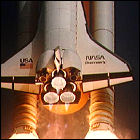 Space Shuttle Discovery returns to orbit for a week-long flight including the deployment of three communications satellites. American, Mexican and Saudi Arabian satellites are launched via payload assist modules. Discovery crew consists of Commander Daniel Brandenstein, Pilot John Creighton, mission specialists Shannon Lucid, John Fabian and Steven Nagel, and payload specialists Patrick Baudry and Sultan Salman Al-Saud (the first Saudi Arabian national to fly in space).
Space Shuttle Discovery returns to orbit for a week-long flight including the deployment of three communications satellites. American, Mexican and Saudi Arabian satellites are launched via payload assist modules. Discovery crew consists of Commander Daniel Brandenstein, Pilot John Creighton, mission specialists Shannon Lucid, John Fabian and Steven Nagel, and payload specialists Patrick Baudry and Sultan Salman Al-Saud (the first Saudi Arabian national to fly in space).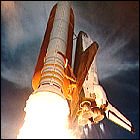 For the first and only time in the history of the shuttle program, Space Shuttle Challenger does an in-flight abort maneuver – in this case, an Abort To Orbit (ATO) following the premature shutdown of one of the shuttle’s main engines. The potentially catastrophic shutdown of a second engine is narrowly avoided by a sharp-eyed ground controller, and Challenger makes it to orbit and the rest of the mission is conducted normally.
For the first and only time in the history of the shuttle program, Space Shuttle Challenger does an in-flight abort maneuver – in this case, an Abort To Orbit (ATO) following the premature shutdown of one of the shuttle’s main engines. The potentially catastrophic shutdown of a second engine is narrowly avoided by a sharp-eyed ground controller, and Challenger makes it to orbit and the rest of the mission is conducted normally.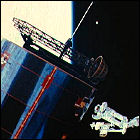 Space Shuttle Discovery lifts off on a mission to deliver three communications satellites to orbit. The triple payload includes SYNCOM IV-4, the Australian AUSSAT-1 satellite, and American Satellite Company’s ASC-1. Discovery is manned on this mission by Commander Joe Engle, Pilot Richard Covey, and mission specialists James van Hoften, John Lounge and William Fisher. The mission lasts one week, and Discovery is able to return home a day early after achieving mission objectives ahead of time.
Space Shuttle Discovery lifts off on a mission to deliver three communications satellites to orbit. The triple payload includes SYNCOM IV-4, the Australian AUSSAT-1 satellite, and American Satellite Company’s ASC-1. Discovery is manned on this mission by Commander Joe Engle, Pilot Richard Covey, and mission specialists James van Hoften, John Lounge and William Fisher. The mission lasts one week, and Discovery is able to return home a day early after achieving mission objectives ahead of time. The Soviet Union launches the Soyuz T-14 mission, carrying a crew of three cosmonauts intended to become the next long-term occupants of space station Salyut 7. The crew consists of Vladimir Vasyutin, Georgi Grechko and Alexander Volkov, though Grechko only remains until September 26th, returning to Earth with the Soyuz T-13 crew. Two months into the crew’s stay on Salyut, however, Vasyutin becomes seriously ill. Communications between the station and ground controllers are carried out on a scrambled frequency for a week, at which point the crew is recalled to Earth, ending an occupancy that was meant to last for half a year. Soyuz T-14 returns to Earth, carring Vasyutin, Volkov and Soyuz T-13 crew member Viktor Savinykh home on November 21st, once again leaving Salyut 7 unoccupied for several months.
The Soviet Union launches the Soyuz T-14 mission, carrying a crew of three cosmonauts intended to become the next long-term occupants of space station Salyut 7. The crew consists of Vladimir Vasyutin, Georgi Grechko and Alexander Volkov, though Grechko only remains until September 26th, returning to Earth with the Soyuz T-13 crew. Two months into the crew’s stay on Salyut, however, Vasyutin becomes seriously ill. Communications between the station and ground controllers are carried out on a scrambled frequency for a week, at which point the crew is recalled to Earth, ending an occupancy that was meant to last for half a year. Soyuz T-14 returns to Earth, carring Vasyutin, Volkov and Soyuz T-13 crew member Viktor Savinykh home on November 21st, once again leaving Salyut 7 unoccupied for several months.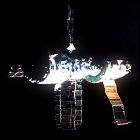 The unmanned Kosmos 1686 module, launched by the Soviet Union in September, successfully completes an automated docking with space station Salyut 7. This new module is a permanent addition to the final Salyut station, offering more habitable space for work and storage aboard the aging station. Kosmos 1686 arrives with nearly 10,000 pounds of supplies and consumables, and serves as a case study to help engineers plan the upcoming Mir space station, which is designed from the outset to consist of several add-on modules.
The unmanned Kosmos 1686 module, launched by the Soviet Union in September, successfully completes an automated docking with space station Salyut 7. This new module is a permanent addition to the final Salyut station, offering more habitable space for work and storage aboard the aging station. Kosmos 1686 arrives with nearly 10,000 pounds of supplies and consumables, and serves as a case study to help engineers plan the upcoming Mir space station, which is designed from the outset to consist of several add-on modules.